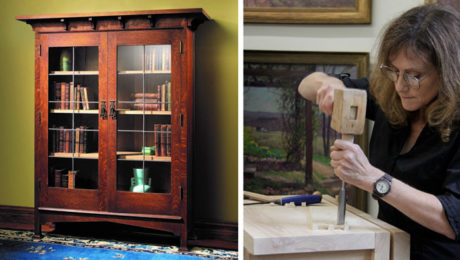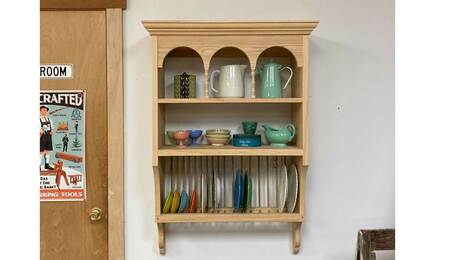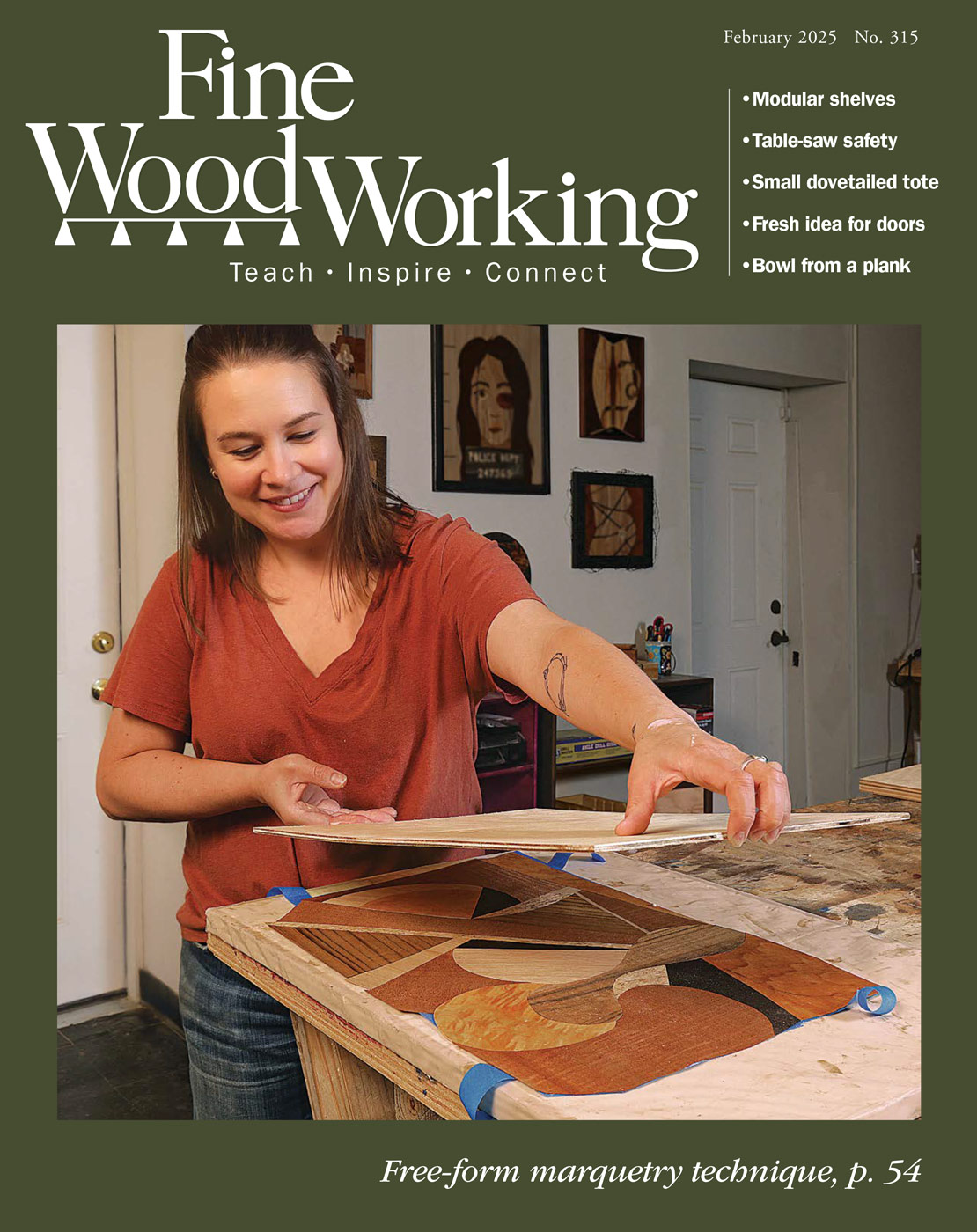Help wanted
Finding and keeping employees is a huge and complex issue for woodworking shops.
Recently I’ve heard a few woodworkers who run small professional shops lament the scarcity of potential employees. In many cases, they say, those who apply for jobs lack the necessary skills; many job applicants also have unrealistic expectations regarding pay. As someone who was employed by a few other shops before opening my own, has been an erstwhile employer, and is more interested in discussing the realities of professional woodworking than the romance of hardwoods and hand tools, I’m as interested in the challenges of running a business as I am in the satisfactions of the work.
These particular conversations put me in mind of the Fine Homebuilding program #KeepCraftAlive, founded to address the growing shortage of skilled workers for the construction industry. It seems to me that small shops making furniture and cabinetry could benefit from some kind of national discussion about realities and fantasies surrounding our trade. Finding and keeping employees is a big issue.
Although the U.S. economy is unsettled, with millions out of work due to the Covid-19 pandemic, the building and remodeling industries remain strong. So do sectors that produce furnishings of all kinds for the home. Not only has home become the workplace for so many Americans (and seems likely to remain so for a good percentage of those who can tele-commute, even after the pandemic is over), driving many to design work-related products, from file cabinets and lighting to desks and chairs, that will fit into a residential interior while being more affordable; it has also left those who are still gainfully employed with discretionary income that they would otherwise be spending on daily commutes, dining out, attending concerts, and vacation travel, making this a good time to invest in a new kitchen, custom desk, or Herman Miller chair. Many woodworking shops are booked out for months; already negotiating delays due to the pandemic, their only hope of meeting deadlines is to hire help.
The challenges of finding employees in our field have many roots. Location may be a factor – if you’re in a rural area, your pool of potential employees is almost certainly smaller than if you’re in a city, especially one where the economy is thriving. There’s the question of skills: it’s rare to find someone you can hire into a shop that’s new to him or her and just press “go”; every shop has its idiosyncrasies – century-old machines or cutting-edge CNC, along with different approaches to joinery and finishing, not to mention personalities and pecking orders. Sometimes it’s best to hire someone with minimal specialized skills and teach him or her your ways of doing things, though it’s hard to take time from your own work, or that of other employees, to train a new hire when you’re already running full-throttle. Then there’s the question of pay: Depending on the kind of work you do, you may not be able to afford someone with the necessary skills; on the other hand, in some cases, even people without woodworking skills expect – or need – to make more than an employer in our field can pay. A positive attitude and solid work ethic are also important qualities that a would-be employer can’t afford to take for granted.
Considering the high standard of training currently available through U.S. woodworking and craft schools, you might imagine small shops have their pick among skilled potential employees. My observation is that only a fraction of these graduates end up taking jobs in the kinds of production shops I’m writing about, many of which earn their bread and butter with a combination of built-ins made from sheet goods and custom work done with techniques that value efficiency over worker satisfaction. While most schools teach traditional techniques and concentrate on the highest-quality materials and most refined practices, the actual market for these skills is small. Some graduates find employment as teachers or administrators in these same schools. Others open their own one- or two-person shop rather than going to work for someone else. Some piece together a livelihood based on custom furniture making and antique restoration, which offers opportunities to practice the intricate, specialized skills learned in their training. Some decide to save their woodworking for their spare time while finding employment in another field.
I recently interviewed two people with very different businesses, both of which do high-end work, on the subject of finding and retaining employees. What follows is not an apples-to-oranges comparison or a comprehensive analysis of the situation, but a few observations from these business owners that may be helpful to others, as well as to those looking for work.
Based near the small town of Nashville, Indiana, Darrin Kean has been building furniture, cabinetry, and millwork for over 30 years. He currently has one full-time employee who has been with him about seven years. Before that he had two – one stayed 12 years, the other 15. Long-term employees are golden for a small business; they know the ropes and are able to work efficiently. There have been other employees; some learned fast, only to leave and start their own businesses.
With a backlog of orders, Darrin would love to hire another employee, but his efforts to find one – calls and written messages to fellow woodworkers, Help Wanted ads – have been unsuccessful. Along with most of those I know who run small woodworking shops, Darrin agrees that when he’s considering a new hire, “it’s not so much the experience they already have as the will and enthusiasm to learn and be proud of what they do. It’s not rocket science, but it does take practice. It really is all about the attitude.”
There’s also a real disconnect between the cost of living and how much a small business can afford to pay someone who is less productive, in addition to needing more guidance and supervision, which takes the employer (or other employees) away from his or her own work. Many have unrealistic expectations of how much they should be paid while they are learning new skills (which students at woodworking schools pay to learn). Some expect $20 an hour from Day One, Darrin says, even though their output may not yet warrant it. In fact, Darrin starts a reliable employee – someone with limited skills but who shows up and works from 7:30 to 4 – at $12 an hour. “They look at the shop – it’s 6,000 square feet – and the house,” he says, and imagine they should be paid more. What they don’t factor in, Darrin says, is “I’ve been at it 37 years.”
Paul Downs, who started his Philadelphia-based furniture business right out of college in the mid-1980s, runs a larger shop with more employees and has put considerable effort into figuring out what it takes to be a good employer, with a workplace that will be attractive to prospective employees, and the kinds of remuneration that will make for a good fit.
“My basic thought is, if [finding employees] is the problem, these company owners need to look in the mirror. The boss demonstrates what the future is. If the boss is barely scraping by, it’s clear the road is not worth the effort. You walk into my shop, it’s a shop; it’s not some kind of fantastic office… It’s a place where adults are working together. It’s clean, it’s well equipped.” (Note: Darrin has checked these boxes.)
He points out that the challenges of finding and retaining good employees are common among other lines of manufacturing. Among those challenges is the ubiquity of cellphones. While Paul has “had good luck with millennials,” he acknowledges that “a kid today is definitely a different animal than a kid of 20 years ago. They have cellphones in their hand. They’re addicted.”
In terms of potential employees, Paul has the advantage of a densely populated urban location near other cities on the east coast. He currently has 12 employees on the shop floor, aside from others in offices and sales. The highest-paid employee is the shop manager, who hired on in 2008, was laid off in the recession, then hired back in 2010; in his 40s, the shop manager is on salary that translates to about $46 an hour.
Most of the employees in cabinetmaking and finishing have worked at Paul Downs for at least two years, some far longer. Most make between $20 and $27 per hour. Depending on their family situation, Paul may also cover their health insurance premiums, and he tries to be flexible in terms of hours for those with family responsibilities. (One employee works a 35-hour week instead of 40 so that he can spend more time helping with childcare.) All of Paul’s employees in cabinetmaking and finishing came with at least some skills. Some of the older employees came with extensive shop experience.
The lowest-paid employee keeps the shop clean and tidy. He’s 50 and is paid $18.50 an hour plus health insurance.
Paul notes he has a lot of people in their 30s and 40s. “They’ve settled into adult life, with commitments.” They have solid reasons to do good work and get along with their employer and colleagues.
Paul emphasizes the importance of seeing employees as a critical investment. What would happen, he wonders, if the employer took $10/hour out of his or her own pocket and paid it to the employee. “If you thought of an employee [the way you think of a machine], like you were buying a new tablesaw…this is something you’re going to pay for. It has the potential to produce work for you, and you expect to pay for it.”
“You’re going to have to do something yourself to make that employee effective,” he goes on. “You may have to pay them enough that they will be a reliable person. You need to pay them enough to remove the option of sitting at home and playing video games all day. You need to remove the impediment of them not being able to get to work. And to remove the other employment choices” such as those that offer higher pay, a happier atmosphere, or a workspace that’s more pleasant to be in. “And you probably have to invest in yourself to make the employee situation look decent. The toilet has to be presentable. The workplace has to be someplace you want to go.”
Furthermore, Paul says it’s crucial that employers ask themselves whether they are good communicators and managers. “I was a bad boss for a long time and got by because we had a nice shop and good equipment. I wasn’t particularly good at managing until I got to be about 50. A lot of management is paying attention to what people’s situation is.” It’s critical, he says, to be able to say to an employee “I need this performance from you” – to be clear about the kind of behavior you expect, and to let people know when they are not toeing the line. There’s a fine line for the employer, too, says Paul. “It can get toxic if you’re always barking at people.”
Finally, Paul lists four of the lessons he has learned as an employer, all of them related to the importance of employers checking their own expectations and working continually to align them with reality. His overarching point: “The stereotype of what it means to be wood craftsman is drifting farther and farther away from the realities of the modern economy.”
- Is the product that’s fun to make and beautiful to the trained eye what the market actually wants?
- The act of selling these days is so different – everybody is exposed to competition for a given product. It’s instantly accessible to anybody with a cellphone. Because of this, pricing is really important; it has to be skewed to delivering value to the customer and not the producer.
- We live in a world of logistics. All products need to be shippable. Logistics is an important part of being a manufacturer. The kind of products [many fine woodworkers] like to make were not designed to be shipped. The customer experience of receiving the goods is likely to be compromised because of the design of the goods. Your ability to deliver across x number of miles defines the extent of your market. Where you choose to locate also defines the extent of your market.
- Your ability and desire to communicate with your clients and employees will determine your success. You need to be a communicator, more than anything, to survive professionally. Part of that is how prompt you are (for example, in returning phone calls or emails).
“If you’re really checking those boxes,” Paul says, “you’re not Sam Maloof anymore. You’re not Sidney Barnsley or the Mouseman. You can’t replicate that [kind of painstaking handcraft] and make a living.”
Nancy Hiller is a professional cabinetmaker who has operated NR Hiller Design, Inc. since 1995. Her most recent books are English Arts & Crafts Furniture and Making Things Work, both available at Nancy’s website.
 |
|
 |
|
 |
Business Insurance Is Non-NegotiableNancy Hiller’s livelihood is almost entirely dependent on her shop, and while insurance premiums are expensive she can’t afford to not pay them |






















Comments
Re: cellphones... I have a friend with an auto repair business employing 40 men. He was losing what he estimated to be 1 man hour per day per man to their text messaging.
He offered lunch to his insurance man and did a shop tour with "the suit" before they ate. At the next employee meeting he explained that the suit saw a man working on someones brakes while arguing with someone on the phone. With the threat of higher insurance rates he put a new policy in place.
Phones were to be left in lockers.
Anyone using a phone while working on a car would be fired.
He had to fire one guy, that was 3+ years ago.
Log in or create an account to post a comment.
Sign up Log in